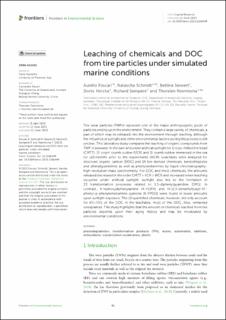| dc.contributor.author | Foscari, Aurelio Giovanni | |
| dc.contributor.author | Schmidt, Natascha | |
| dc.contributor.author | Seiwert, Bettina | |
| dc.contributor.author | Herzke, Dorte | |
| dc.contributor.author | Sempere, Richard | |
| dc.contributor.author | Reemtsma, Thorsten | |
| dc.date.accessioned | 2023-06-28T06:55:06Z | |
| dc.date.available | 2023-06-28T06:55:06Z | |
| dc.date.created | 2023-06-26T13:50:48Z | |
| dc.date.issued | 2023 | |
| dc.identifier.citation | Frontiers in Environmental Science. 2023, 11, 1206449. | en_US |
| dc.identifier.issn | 2296-665X | |
| dc.identifier.uri | https://hdl.handle.net/11250/3073861 | |
| dc.description.abstract | Tire wear particles (TWPs) represent one of the major anthropogenic pools of particles ending up in the environment. They contain a large variety of chemicals, a part of which may be released into the environment through leaching, although the influence of sunlight and other environmental factors during this process is still unclear. This laboratory study compares the leaching of organic compounds from TWP in seawater in the dark and under artificial sunlight for 1) cryo-milled tire tread (CMTT), 2) ‘virgin’ crumb rubber (VCR) and 3) crumb rubber immersed in the sea for ≥12 months prior to the experiments (WCR). Leachates were analyzed for dissolved organic carbon (DOC) and 19 tire-derived chemicals, benzothiazoles and phenylguanidines as well as phenylendiamines by liquid chromatography-high resolution-mass spectrometry. For DOC and most chemicals, the amounts released decreased in the order CMTT > VCR > WCR and increased when leaching occurred under artificial sunlight. sunlight also led to the formation of 23 transformation processes related to 1,3-diphenylguanidine (DPG). In contrast, 4-hydroxydiphenylamine (4-HDPA) and N-(1,3-dimethylbutyl)-N′-phenyl-p-phenylenediamine quinone (6-PPDQ) were found in lower amounts upon sunlight exposure. The 19 quantified chemicals, however, did only account for 6%–55% of the DOC in the leachates; most of the DOC, thus, remained unexplained. This study highlights that the amount of chemicals leached from tire particles depends upon their aging history and may be modulated by environmental conditions. | en_US |
| dc.language.iso | eng | en_US |
| dc.rights | Navngivelse 4.0 Internasjonal | * |
| dc.rights.uri | http://creativecommons.org/licenses/by/4.0/deed.no | * |
| dc.title | Leaching of chemicals and DOC from tire particles under simulated marine conditions | en_US |
| dc.title.alternative | Leaching of chemicals and DOC from tire particles under simulated marine conditions | en_US |
| dc.type | Peer reviewed | en_US |
| dc.type | Journal article | en_US |
| dc.description.version | publishedVersion | en_US |
| dc.rights.holder | © 2023 Foscari, Schmidt, Seiwert, Herzke, Sempéré and Reemtsma. | en_US |
| dc.source.volume | 11 | en_US |
| dc.source.journal | Frontiers in Environmental Science | en_US |
| dc.identifier.doi | 10.3389/fenvs.2023.1206449 | |
| dc.identifier.cristin | 2158091 | |
| dc.relation.project | NILU - Norsk institutt for luftforskning: 120077 | en_US |
| dc.relation.project | Norges forskningsråd: 311313 | en_US |
| dc.source.articlenumber | 120644 | en_US |
| cristin.ispublished | true | |
| cristin.fulltext | original | |
| cristin.qualitycode | 1 | |

